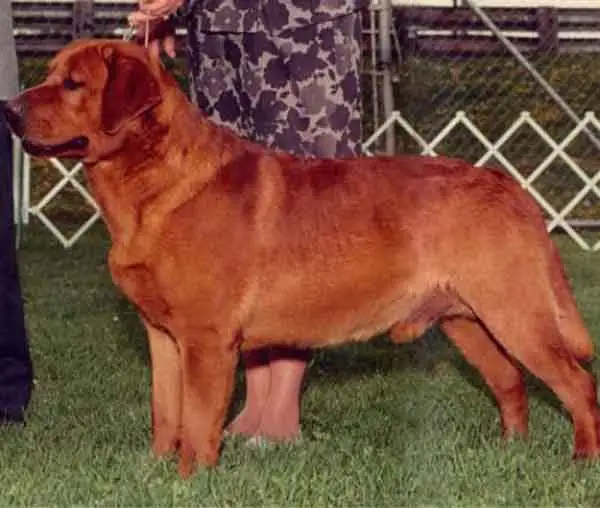The origins of the labrador fox red

Ben of Hyde, the first yellow Labrador officially recognized
King George V1 and Queen Elizabeth with their dark yellow Labrador in 1920
Glenda Crook and Sh.Ch.Balrion King
Frost, winner of the C.C. to the Labrador
1980 Retriever Club Show. Judge:
Mrs. Mary Wilkinson (Keithray)
Fox red is not a distinct color of the Labrador, it is just a particular shade of yellow. In the early development of the breed, Fox-red or dark yellow was the Labrador Retriever’s original yellow color. The first yellow Labradors were in fact called golden, until the British Kennel Club made them official as yellow. The motivation was that “gold is not a color”, and so they have been called yellow. Just look at the first recorded yellow Labrador, Ben of Hyde (1899, male) born of Radclyffe’s Neptune (1892, black) x Tapper’s Duchess (<1890, black, unregistered, for which we have no pedigree), to see how the hue yellow was originally. These early Labradors were of a hue that approached dark gold or cream toffee with a red overtone.
Over the years, lighter-colored Labradors have become much more popular and we have lost the habit of the original color of the yellow Labrador. The opinion is still widespread today that the lighter the color of yellow, the better. Some breeders advertise a so-called white Labrador; although there is nothing to complain from a genotype point of view, this constitutes a break with the history of our race. Due to the lack of interest and popularity for the darker – perfectly in standard – shade of yellow, these variants had practically disappeared. Two UK breeders, John and Glenda Crook (Balrion) and Mac Bedford (Wynfaul) had maintained an interest in dark yellow; this interest that led to the rebirth of fox red. One of the most famous Labradors of all time, owned by the Crook, Ch. Balrion King Frost (1976), attracted attention in his litters for producing very dark yellows.
Ch. Wynfaul Tabasco (1986)
It was one of his daughters who produced the great CH.Whynfaul Tabasco (1986), the progenitor of the newer foxred labradors. Tabasco not only had a splendid red coat, but was gifted with an excellent conformation. He became the only modern fox red beauty champion in the united kingdom. The next step, always carrying on the line of Balrion King Frost, was a litter between Wynfaul Tabasco and Lady Bountiful of Balrion of very dark yellow color, daughter of CH Balrion Kings Ransom, in turn son of King Frost. The resulting litter was all fox red, confirming Crook’s intuition that two fox reds would only produce fox red kittens. In this litter there was a red male puppy, sold to Sally Kelley (Kelleygreen) in the United States, Balrion Red Alert (1990).
Balrion Red Alert (1990)
Two breeders, the aforementioned Sally Kelly and Judy and Josh McCormick (Keepsake), using especially Red Alert, have done a lot in recent years to bring forward the oldest color: in most of the pedigrees of all fox reds today, a some research will show this dog many times. Sally Kelly then purchased from Dot Galvin (Hennings Mill), a fox red mare, Hennings Mill Henna (1992), reprising King Frost through Ch. Scartho Frost (1991). Sally Kelly mated her with Red Alert, and the litter was all fox. In this litter there was another special Labrador: Kelleygreen Kardinal (1995) .


Scrimshaw Placido Flamingo
Many of the contemporary fox reds can be found in the Kardinal pedigree 1-3 generations back. Another dog, although not particularly famous, influenced the fox red lines Kelleygreen and Keepsake: it is Scrimshaw Placido Flamingo (1996), called Tenor. Tenor was bred by Barbara Barfield (Scrimshaw) and is the son of Ch. Duckless Fairbank (1986) and is the grandson of the very famous Ch. Lindall Mastercraft (1980). Tenor inherited the red hue from both sides of his pedigree: his grandfather GB Ft. Ch. Venture Of Brattonsplash (1978), while his mother Henderland Candach (1990) was dark yellow, but had the red color in his ancestors. Tenor passed the “C” allele, (responsible for the concentration of red pheomelanin in the pigments of the coat) to his offspring: but this exceptional fox red not only transmitted the hue of the color to his descendants, but also his wonderful and affable temperament; he really was what a Labrador should be, a true gentleman in every sense of the word.




